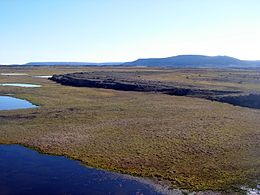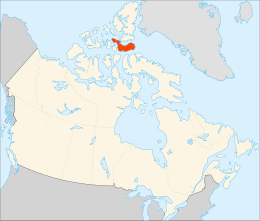
Back Devon-eiland Afrikaans جزيرة ديفون Arabic جزيره ديفون ARZ Islla Devon AST Devon (ada) Azerbaijani Дэван (востраў) Byelorussian Дэван (востраў) BE-X-OLD Девън (остров) Bulgarian Enez Devon Breton Illa Devon Catalan
Native name: ᑕᓪᓗᕈᑎᑦ | |
|---|---|
 Truelove Lowland, a polar oasis located in Devon Island | |
 | |
| Geography | |
| Location | Baffin Bay |
| Coordinates | 75°15′N 088°00′W / 75.250°N 88.000°W[1] |
| Archipelago | |
| Area | 55,247 km2 (21,331 sq mi) |
| Area rank | 27th |
| Length | 524 km (325.6 mi) |
| Width | 155–476 km (96–296 mi) |
| Highest elevation | 1,920 m (6300 ft) |
| Highest point | Devon Ice Cap |
| Administration | |
Canada | |
| Territory | Nunavut |
| Region | Qikiqtaaluk |
| Demographics | |
| Population | 0 |
Devon Island (Inuktitut: ᑕᓪᓗᕈᑎᑦ, Tallurutit)[2] is an island in Canada and the largest uninhabited island (no permanent residents) in the world. It is located in Baffin Bay, Qikiqtaaluk Region, Nunavut, Canada. It is one of the largest members of the Arctic Archipelago, the second-largest of the Queen Elizabeth Islands, Canada's sixth-largest island, and the 27th-largest island in the world. It has an area of 55,247 km2 (21,331 sq mi) (slightly smaller than Croatia). The bedrock is Precambrian gneiss and Paleozoic siltstones and shales.[3] The highest point is the Devon Ice Cap at 1,920 m (6,300 ft) which is part of the Arctic Cordillera. Devon Island contains several small mountain ranges, such as the Treuter Mountains, Haddington Range and the Cunningham Mountains. The notable similarity of its surface to that of Mars has attracted interest from scientists.
- ^ "Devon Island". Geographical Names Data Base. Natural Resources Canada.
- ^ Jerry Kobalenko. The Horizontal Everest: Extreme Journeys on Ellesmere Island. BPS Books, 2010
- ^ kuschk (3 May 2012). "Devon Island: The Largest Uninhabited Island on Earth". Basement Geographer. Archived from the original on 2016-03-04. Retrieved 27 February 2014.
© MMXXIII Rich X Search. We shall prevail. All rights reserved. Rich X Search